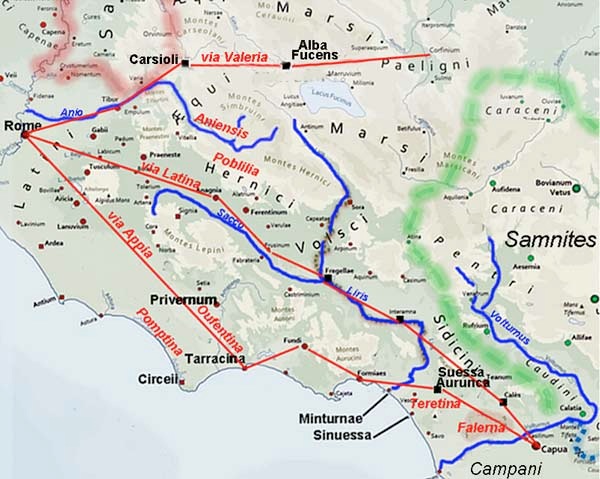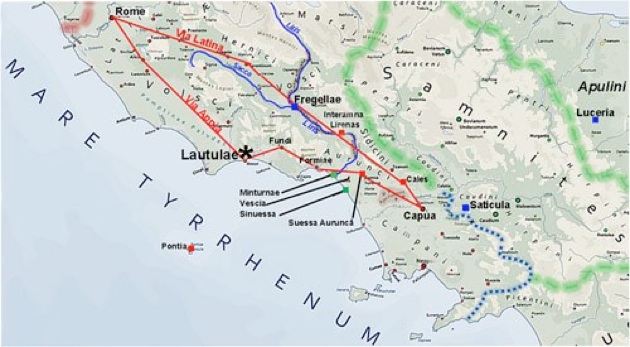Census of 299 BC

According to Livy, this year witnessed:
-
“... the closing of the lustrum by the censors Publius Sempronius Sophus and Publius Sulpicius Saverrio, and two tribes were added: the Aniensis; and the Teretina”, (‘History of Rome’, 10: 9: 14).
These were the first tribes that had been created since 318 BC (which had seen the creation of the Falerna and the Oufentina). The fasti Capitolini add that these censors completed the 29th lustrum.
Aniensis Tribe
Lily Ross Taylor (referenced below, at p. 56) pointed out, that the Aniensis was clearly named for the Anio valley, which indicates that it was created for citizens who were settled on land confiscated from the Aequi .
Livy (‘History of Rome’, 10: 13: 1) recorded the foundation of theLatin colony of Carseoli on Aequan territory in 298 BC. When Trebula Suffenas and Carseoli were enfranchised after the Social War, they were both assigned to the Aniensis, as were two other centres that had nucleated on confiscated Aequan land: Afilae and Treba (marked on the map above).
[I wonder whether Trebula Suffenas functioned as a Roman prefecture from 303 BC, although that can only be a matter for speculation. ]
Teretina Tribe

Red squares = Latin colonies on land confiscated from the Aurunci/ Ausones:
Cales (334 BC, refounded 313 BC; Suessa Aurunca and Pontiae (313 BC0 Interamna Lirena (312 BC)
Blue squares = Maritime citizen colonies on land confiscated from the Aurunci/ Ausones:
Minturnae and Sinuessa (296 BC)
According to Festus:
“TERETINATIBUS; a flumine Terede dicti existimantur, et syllaba cius tertia mutata, et pro Teredc Teram scribi debuisse”, (‘De verborum significatione’, 498 Lindsay)
Bruce Woodward Frier (reference below, 1t p. 123, note 1) observed that:
-
“Mommsen [referenced below] proposed:
-
‘TERETINA TRIBUS: a flumine Terede dicta existimatur: it is supposed that the Teretina tribe is named for the river Terede.’
-
The rest of the note is garbled, but it evidently discussed variants of the river.”
Stephen Oakley (referenced below, 2007, at p. 150) observed that Mommsen had:
-
“... argued that the mysterious [river] ‘Terede’ referred to the Trerus [also known as the] Sacco, and he was followed by Beloch [referenced below, at pp. 33, 417, 585-6], who held that the tribe was established on land recently confiscated from Frusino. [However, Lily Ross Taylor, referenced below, at p. 57-9] rightly rejected this hypothesis ... : noting that [the maritime citizen colonies of Minturnae and Sinuessa, which were founded in 296 BC] were placed in the Teretina, she convincingly argued that the territory of this tribe is likely to have consisted of land confiscated from the Aurunci after their final defeat in 314 BC.”
Conquest of the Aurunci/ Ausones
By the 4th century BC, the Aurinci occupied the lower Liris valley, when a related tribe, the Ausones, was concentrated around Cales, on the border of Campania. These tribes were allied against Rome during the Second Latin War (341-338 BC), and their territory was the site of the Roman victory at the now-unknown Trifanum in 340 BC. The Aurunci probably surrendered and were probably given an alliance with Rome after this battle.
Latin Colony at Cales (334 BC
The Ausones joined the neighbouring Sidicini in a revolt in 335 BC, at which point their strategically-located stronghold at Cales fell to the Romans. This site was used for the foundation of a Latin colony in the following year. It is possible that the Romans withdrew from Cales under the terms of the so-called Caudine Peace (321 BC) with the Samnites.
Latin Colonies of Suessa Aurunca, Pontiae
In 315 BC, after the Samnites defeated the Romans at Lautulae, at least three strongholds of the Aurunci, at Ausona (now unknown), Minturnae, and Vescia, defected to the Samnites. According to Livy, having been betrayed by a pro-Roman faction:
-
“... the three towns were taken in an hour ... Because the leaders were not present when the attacks were made, there was no limit to the slaughter, and the Ausonian nation was wiped out ...”, (‘History of Rome’, 9: 25: 8-9).
Stephen Oakley (referenced below, 1998 at p. 266) observed that this was:
-
“... the last recorded resistance of the Aurunci: it must have been mercilessly put down by the Romans, and it was followed by confiscations to provide land for:
-
✴the Latin colonies at Suessa Aurunca, [Pontiae, on an off-shore island] and Interamna Lirenas [founded in 313-2 BC];
-
✴settlers of the tribe Teretina, [which was established in 299 BC - see below]; and
-
✴the [maritime, citizen] colonies at Minturnae and Sinuessa [founded in 296 BC - see below].
If the original colony at Cales had been withdrawn in 321 BC, then it would almost certainly have been re-founded in 313 BC.
After the Social War (ca, 90 BC), Cales, Suessa Aurunca and Interamna Lirenas all became municipia with voting rights:
-
✴Cales was assigned to the Poblilia (perhaps because this was the tribe of Q. Fufius Calenus, see Lily Ross Taylor, referenced below, at p. 215);
-
✴Suessa Aurunca was assigned to the Aemilia, the tribe of nearby Formiae and Fundi from 188 BC; and
-
✴Interamna Lirenas was assigned to the Teretina.
Via Latina
The road that the Romans called via Latina, which connected Rome to Capua, followed the Sacco and Liris valleys. Stephen Oakley (referenced below, 2005, at p. 371) pointed out that:
-
“The date of its construction is uncertain and, indeed, [it is not clear that] it ever was formally constructed: probably, there had always been a route down these valleys, and it would not be surprising if the quality of a [pre-existing] road was enhanced ... when Latin colonies were established at Cales (334 BC)], Fregellae (328 BC) and Interamna Lirenas (312 BC)”
Giovanna Bellini and colleagues (referenced below, at p. 3) pointed out that:
-
“The area was inhabited by the Volsci and the Ausones/Aurunci and [by the late 4th century BC, had become] the focus of the clash between Rome and the Samnites in their struggle to control Campania. The foundation of the Latin colonies of [Cales, Fregellae and Interamna Lirenas ... on the via Latina, was imposed at the expense of earlier settlements and sounded the death knell of Samnite presence in the region.”
Establishment of the Teretina Tribe (299 BC)
Clearly, by 299 BC, the extent of citizen settlement in this area justified the creation of a new voting tribe. Stephen Oakley (referenced below, 2005, at p. suggested that it is therefore:
-
“... quite likely that the Aurunci were incorporated into the Roman state optimo iure.”
However, it seems to me that the local population might well have been more or less wiped out (as Livy claimed), in which case the Teretina would have been created for viritane citizen settlers on their land. Any Romans settled here would have retained their existing tribal assignation until 299 BC.
Maritime Colonies at Minturnae and Sinuessa
In 296 BC, during the Third Samnite War, the consul Lucius Volumnius Flamma Violens suppressed a Samnite incursion into northern Campania. Livy described the relief felt in Rome when this news arrived, and continued:
-
“The next question was the protection of the district that had been devastated by the Samnites. It was decided to settle bodies of colonists about the Vescinian and Falernian country.
-
✴One was to be at the mouth of the Liris, now called the colony of Minturnae.
-
✴The other was to be in the Vescinian forest, where it is contiguous with the territory of Falernum. Here, the Greek city of Sinope is said to have stood and, from this, the Romans gave the place the name of Sinuessa.
-
It was arranged that the tribunes of the plebs should get a plebiscite passed requiring P. Sempronius, the praetor, to appoint commissioners for the founding of colonies in those spots. But it was not easy to find people to be sent to what was practically a permanent outpost in a dangerously hostile country: [potential colonists preferred to have] fields allotted to them for cultivation”, (‘History of Rome’, 10: 21: 7-10).
The two new citizen colonies were assigned to the Teretina tribe. Graham Mason (referenced below, at p. 82) suggested that:
-
“The main reason for founding both Mintunae and Sinuessa was to secure ... the neighbouring fertile lands from the ravages of the Samnites, who had repeatedly overrun the area. Livy ... says as much. ... [The apparent reluctance of prospective colonists] implies no negative attitude toward the two sites as such ... It reflects the circumstances of that point in the Third Samnite War: there was another attempted Samnite incursion into the area the following year ”
However, with the end of the war in 290 BC, the barriers to citizen settlement would have disappeared. Furthermore, it is possible that a more extensive programme for settling this fertile plain was facilitated by the protection of the new colonies.
Read more:
G. Bellini et al., “Roman Colonial Landscapes: Interamna Lirenas and its Territory through Antiquity” (2013) online
S. Oakley, “A Commentary on Livy, Books VI-X:Volume III: Book IX”, (2005) Oxford
L. Ross Taylor, “The Voting Districts of the Roman Republic: The 35 Urban and Rural Tribes”, (1960) Rome
J. Beloch, “Römische Geschichte bis zum Beginn der Punischen Kriege”, (1926) Berlin and Leipzig
Th. Mommsen, “Zu Festus”, Rheinisches Museum für Philologie, Neue Folge, 12 (1857) 467-9
Return to Site Map: Romans



